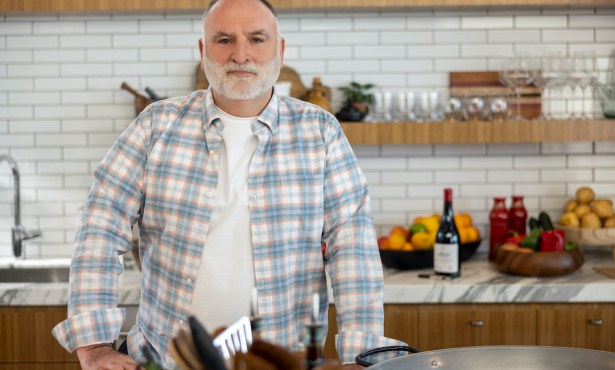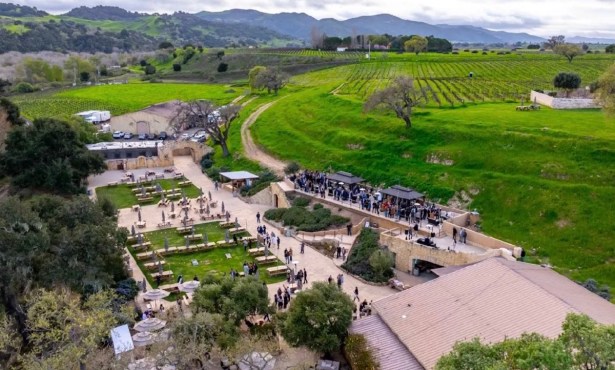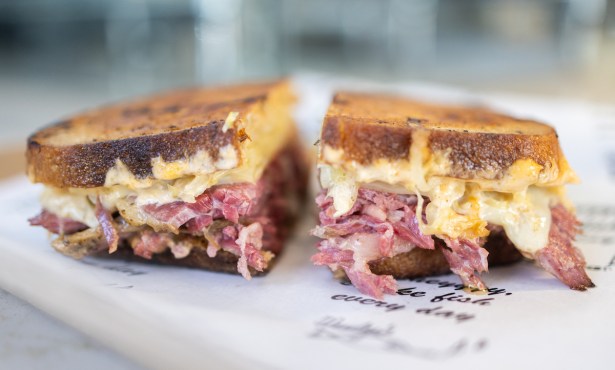Food for Olympians, Beijing Style
A Culinary Adventure in China Reveals What's on the Olympic Games' Menu

Intrigued by China’s recent economic changes, last year I began wondering, “How could a country grow so fast?” So to answer my question, I went to eat Chinese.
Though the Olympics in Beijing wouldn’t begin for more than a year, the city was getting ready-and fast. The government was reeducating men who spit publicly. Giant banners advertising products marketed the upcoming games. The skyline was filled with cranes and steel skeletons 50 stories high.
Amid the frenetic growth, my boyfriend, Mike, and I timidly entered hutong neighborhoods (alleyway ghettos) like trespassers into someone’s living quarters. But their small, hole-in-the-wall restaurants with four tables and grimy, steamy glass portended unappetizing research. Instead, we ate our first Chinese meal, Peking duck, at King Duck Restaurant, recommended by a fellow Los Ba±os swimmer in Santa Barbara who often traveled to China.
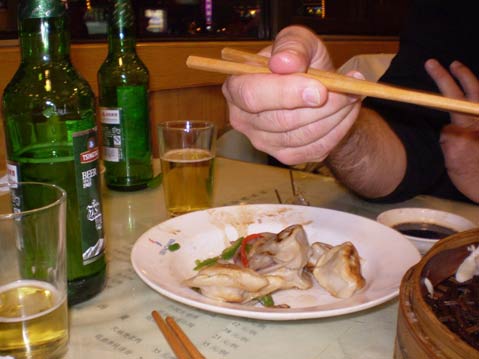
Upstairs, we sat next to a window of roasted, hanging duck carcasses. The hostess slid gold silk fabric sleeves over the tall-backed chairs to cover our coats yet the strong duck smell permeated the leather and wool. A silent boy in a white hat and jacket carved the duck tableside. He covered slices of dark meat with thick, amber-colored fried skin. We made little Chinese burritos by wrapping the duck breast in thin, small steamed pancakes, stuffing them with garlic, scallions, cucumber, and hoisin sauce.
Five minutes later, our duck reappeared, ground and fried with onions, with nothing to absorb the duck grease. It was delicious. The third round arrived in a huge bowl of milky duck bone soup with pieces of tofu and green vegetables. Last were watermelon and mandarin orange slices, a dessert we had often.
Each morning began with a buffet breakfast at the Peninsula Palace Hotel. Eastern breakfast included congee (a watery rice porridge), dried fruit, boiled Jaiozi dumplings stuffed with pork or shrimp, and my favorite: vermicelli noodles fried with eggs and green onions.
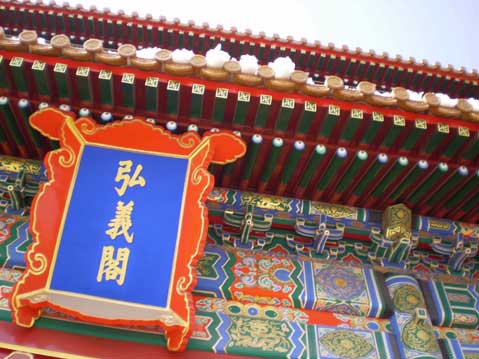
We walked to the Forbidden City, faces wrapped against the freezing wind from the Manchurian plains, and wandered through this imperial palace built in the 1400s. I wanted hot tea-or anything hot. Snow had collected in the corners of the Ming Dynasty palace, vibrant with red, blue, and gold designs. Perhaps a few of the approximately 900 buildings could provide a cozy tea house without too much historical damage, but the cafes we found didn’t have running water. Large floral-patterned Thermoses sat on floors behind the counters, and tepid water was poured into dried soup or hot chocolate mix. Local protest over its proximity to the Forbidden City even closed a Starbucks Cafe.
We escaped the cold in the Hyatt near Tiananmen Square and watched China through a scrim of Western service and standards. The glass atrium covered a sprawling choice of cafes and lounges. I drank smooth oolong tea from a covered white porcelain cup. Pu’erh tea was currently popular in Beijing, but its perfume was too musty for me.
We asked the concierge for a locals-only place to eat dinner. “Tom” wrote directions for the cab driver in Chinese characters. He sent us to “a true noodle place,” Zhajiang Noodle King. As we entered the brightly lit dining room hung with red lanterns and two happy-look altars, a waiter in a blue tunic apron greeted us with a loud “Ni hao!” (Hello). Another waiter responded as loudly. The diners next to us spit out bones on the table.
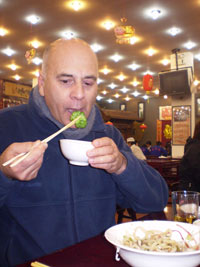
We slurped fat, wet, beige noodles with steamed broccoli lightly tossed in sesame oil. The slimy eggplant was good and garlicky but difficult to eat with chopsticks. Each beer we ordered was announced with “TsingTao!”
On our last day in Beijing, I insisted on a tea ceremony, despite the tourist spin and expense, especially at Lao She Tea House. A gorgeous young woman escorted us into a room. We were mesmerized by the seductive twisting of her wrists, washing the oolong leaves, pouring hot water into a pot over the washed leaves, and then serving the tea. One cup was filled, rinsed, and put up to the eye. In another cup, we drank the tea “in three mouths,” as we were told. As she poured, she splashed water onto the bamboo tray.
The oolong tea was excellent. After several pots, we were buzzing. We ordered a Donkey Roll whose texture of bean curd and rice dough was underdone for me, but the thoroughly baked white cookie with black sesame seeds sprinkled on top was yummy.
We left Beijing by overnight train to Xi’an to see the Terra Cotta soldiers. The cavernous train station was colorless, but its cafeteria served gorgeous hot and cold vegetables: green beans sauteed with sesame seeds, a shiny pea pod salad, Asian cucumbers tossed in oil, and sauteed bok choy. The vegetables were perfectly cooked, crisp, and bright.
I hope the Olympians are eating as well as I did.
4•1•1
For a full list of Chinese restaurants in Santa Barbara, see independent.com/chinese-restaurants.

